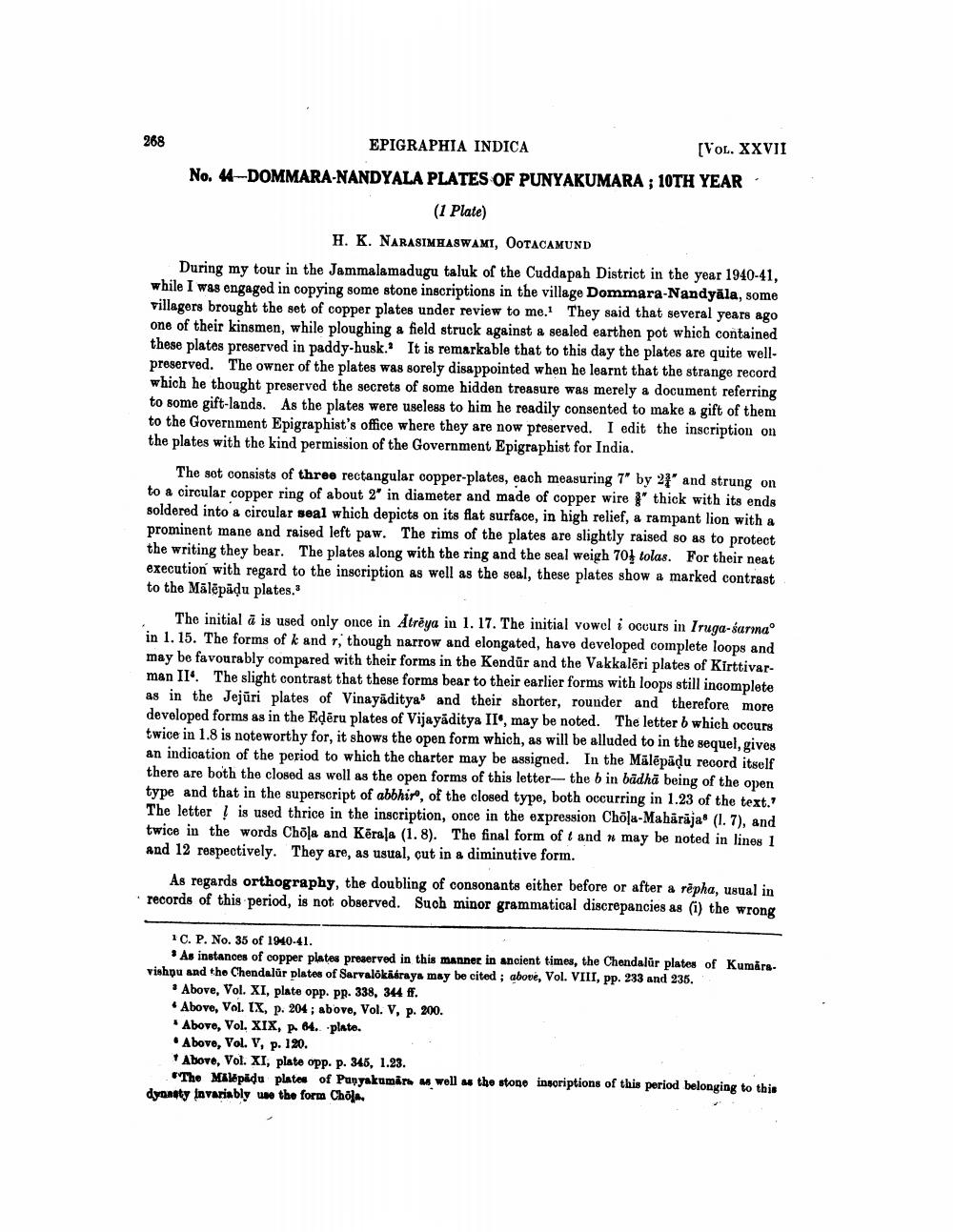________________
268 EPIGRAPHIA INDICA
[Vol. XXVII No. 44--DOMMARA-NANDYALA PLATES OF PUNYAKUMARA ; 10TH YEAR
(1 Plate)
H. K. NARASIMHASWAMI, OOTACAMUND During my tour in the Jammalamadugu taluk of the Cuddapah District in the year 1940-41, while I was engaged in copying some stone inscriptions in the village Dommara-Nandyāla, some villagers brought the set of copper plates under review to me. They said that several years ago one of their kinsmen, while ploughing a field struck against a sealed earthen pot which contained these plates preserved in paddy-husk. It is remarkable that to this day the plates are quite wellpreserved. The owner of the plates was sorely disappointed when he learnt that the strange record which he thought preserved the secrets of some hidden treasure was merely a document referring to some gift-lands. As the plates were useless to him he readily consented to make a gift of them to the Government Epigraphist's office where they are now preserved. I edit the inscription on the plates with the kind permission of the Government Epigraphist for India.
The set consists of three rectangular copper-plates, each measuring 7" by 27" and strung on to a circular copper ring of about 2" in diameter and made of copper wire " thick with its ends soldered into a circular seal which depicts on its flat surface, in high relief, a rampant lion with a prominent mane and raised left paw. The rims of the plates are slightly raised so as to protect the writing they bear. The plates along with the ring and the seal weigh 704 tolas. For their neat execution with regard to the inscription as well as the seal, these plates show a marked contrast to the Mālēpādu plates,
The initial à is used only once in Atrêya in 1.17. The initial vowel i occurs in Iruga-sarma in 1.15. The forms of k and r, though narrow and elongated, have developed complete loops and may be favourably compared with their forms in the Kendür and the Vakkalēri plates of Kirttivarman II. The slight contrast that these forms bear to their earlier forms with loops still incomplete as in the Jejūri plates of Vinayādityas and their shorter, rounder and therefore more developed forms as in the Eļēru plates of Vijayaditya II', may be noted. The letter b which occurs twice in 1.8 is noteworthy for, it shows the open form which, as will be alluded to in the sequel, gives an indication of the period to which the charter may be assigned. In the Mälēpādu record itself there are both the closed as well as the open forms of this letter--the b in bādhā being of the open type and that in the superscript of abbhir, of the closed type, both occurring in 1.23 of the text. The letter ! is used thrice in the inscription, once in the expression Chõla-Mahärāja" (1.7), and twice in the words Chola and Kerala (1.8). The final form of t and u may be noted in lines 1 and 12 respectively. They are, as usual, cut in a diminutive form.
As regards orthography, the doubling of consonants either before or after a répha, usual in · records of this period, is not observed. Such minor grammatical discrepancies as (i) the wrong
1C. P. No. 35 of 1940-41.
• As instances of copper plates preserved in this manner in ancient times, the Chendalur plates of Kumarsvishpu and the Chendalur plates of Sarvalókäsraya may be cited ; above, Vol. VIII, pp. 233 and 235.
. Above, Vol. XI, plate opp. pp. 338, 344 ff. . Above, Vol. IX, p. 204 ; above, Vol. V, p. 200. "Above, Vol. XIX, p. 64. plate. . Above, Vol. V, p. 120. *Above, Vol. XI, plate opp. p. 345, 1.23.
"The Milēpädu plates of Panyakumara u well as the stone inscriptions of this period belonging to this dynasty invariably use the form Chola.




